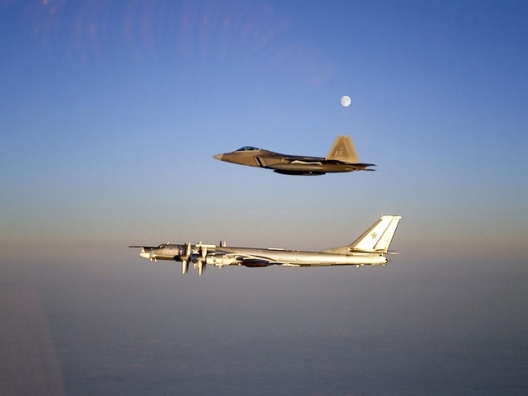 Four Russian strategic bombers triggered U.S. air defense systems while conducting practice bombing runs near Alaska this week, with two of the Tu-95 Bear H aircraft coming within 50 miles of the California coast, the North American Aerospace Defense Command (Norad) confirmed Wednesday.
Four Russian strategic bombers triggered U.S. air defense systems while conducting practice bombing runs near Alaska this week, with two of the Tu-95 Bear H aircraft coming within 50 miles of the California coast, the North American Aerospace Defense Command (Norad) confirmed Wednesday.
“The last time we saw anything similar was two years ago on the Fourth of July,” Navy Capt. Jeff Davis, a Norad spokesman, told the Free Beacon.
Davis said the latest Bear H incursions began Monday around 4:30 p.m. Pacific time when radar detected the four turbo-prop powered bombers approaching the U.S. air defense zone near the far western Aleutian Islands.
Two U.S. Air Force F-22 jets were scrambled and intercepted the bombers over the Aleutians.
After tracking the bombers as they flew eastward, two of the four Bears turned around and headed west toward the Russian Far East. The bombers are believed to be based at the Russian strategic base near Anadyr, Russia.
The remaining two nuclear-capable bombers then flew southeast and around 9:30 P.M. entered the U.S. northern air defense zone off the coast of Northern California.
Two U.S. F-15 jets were deployed and intercepted the bombers as they eventually flew within 50 miles of the coast before turning around and heading west.
A defense official said the four bombers also were supported by two IL-78 aerial refueling tankers that were used for mid-air refueling during the operation this week.
The Tu-95 is a long-range strike aircraft capable of carrying nuclear cruise missiles. Other versions are equipped with intelligence-gathering sensors and electronic warfare gear. It has a range of around 9,400 miles without refueling. . . .
The bomber incursion is the latest Russian nuclear saber-rattling amid stepped up tensions over Moscow’s military annexation of Ukraine’s Crimea.
Image: F-22A Raptor intercepts Russian TU-95 Bear bomber near Alaskan airspace, Nov. 22, 2007 (photo: USAF)
